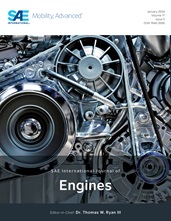Sequential Identification of Engine Subsystems by Optimal Input Design
- Event
- Content
- Complexity and nonlinearity of engines makes precise first principle engine models often difficult to obtain, as for instance for emissions. System identification is a well known possible alternative, successfully used in several automotive applications. In most cases system identification is concerned with the estimation of the unknown parameters of a known set of equations. Unfortunately, for many engine subsystems, there is no sufficiently precise or real time suitable model. This paper presents a sequential algorithm which allows to derive real time suitable models on line by a combination of model structure hypothesis of increasing complexity and an associated optimal input design and selection process. This paper introduces the method and shows its use both for a rather simple and a very difficult engine identification task, a dynamical model of the airpath of a Diesel engine and a dynamical model of nitrogen oxides and particulate matter.
- Pages
- 8
- Citation
- Hirsch, M., and Re, L., "Sequential Identification of Engine Subsystems by Optimal Input Design," SAE Int. J. Engines 2(2):562-569, 2010, https://doi.org/10.4271/2009-24-0132.
